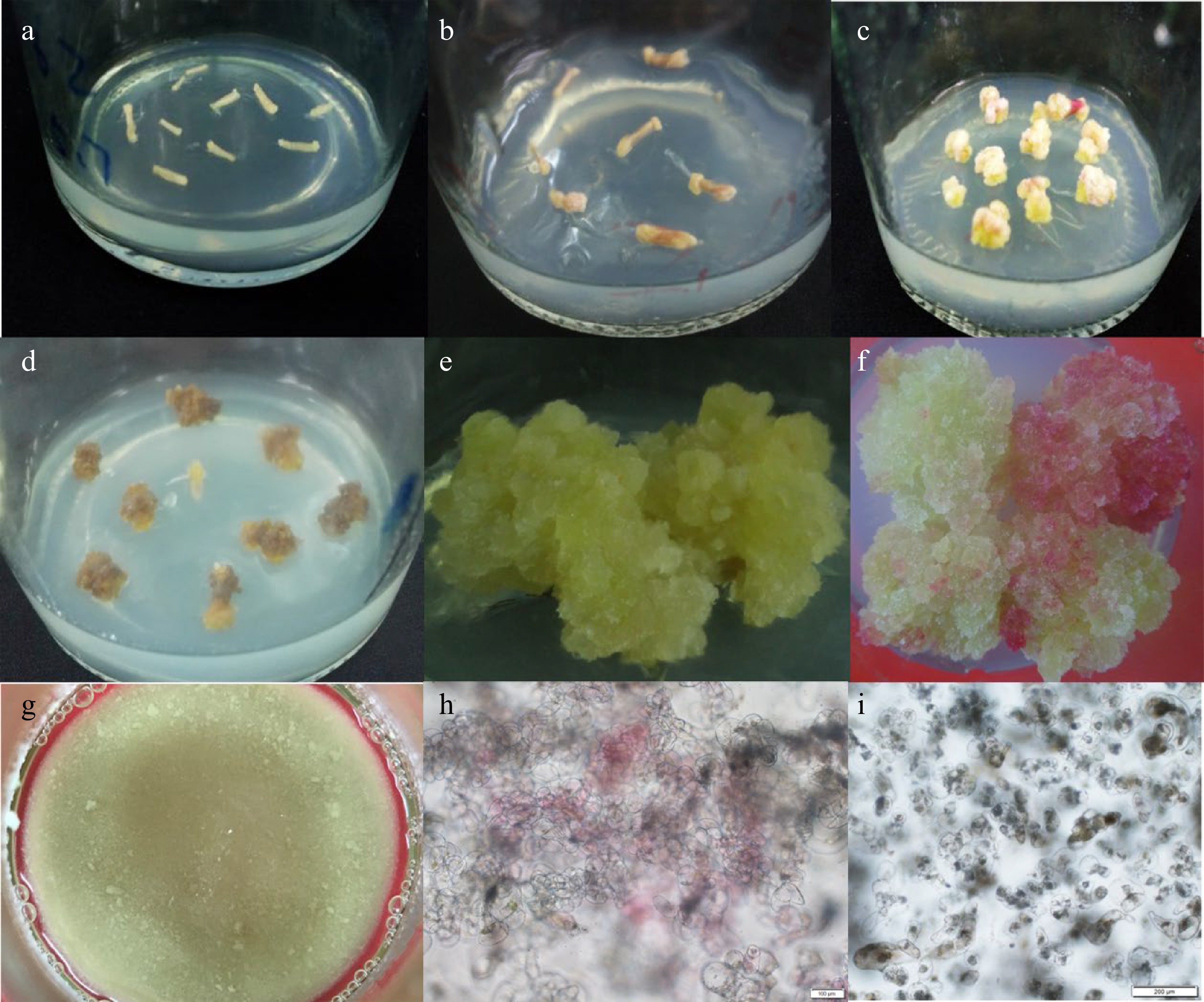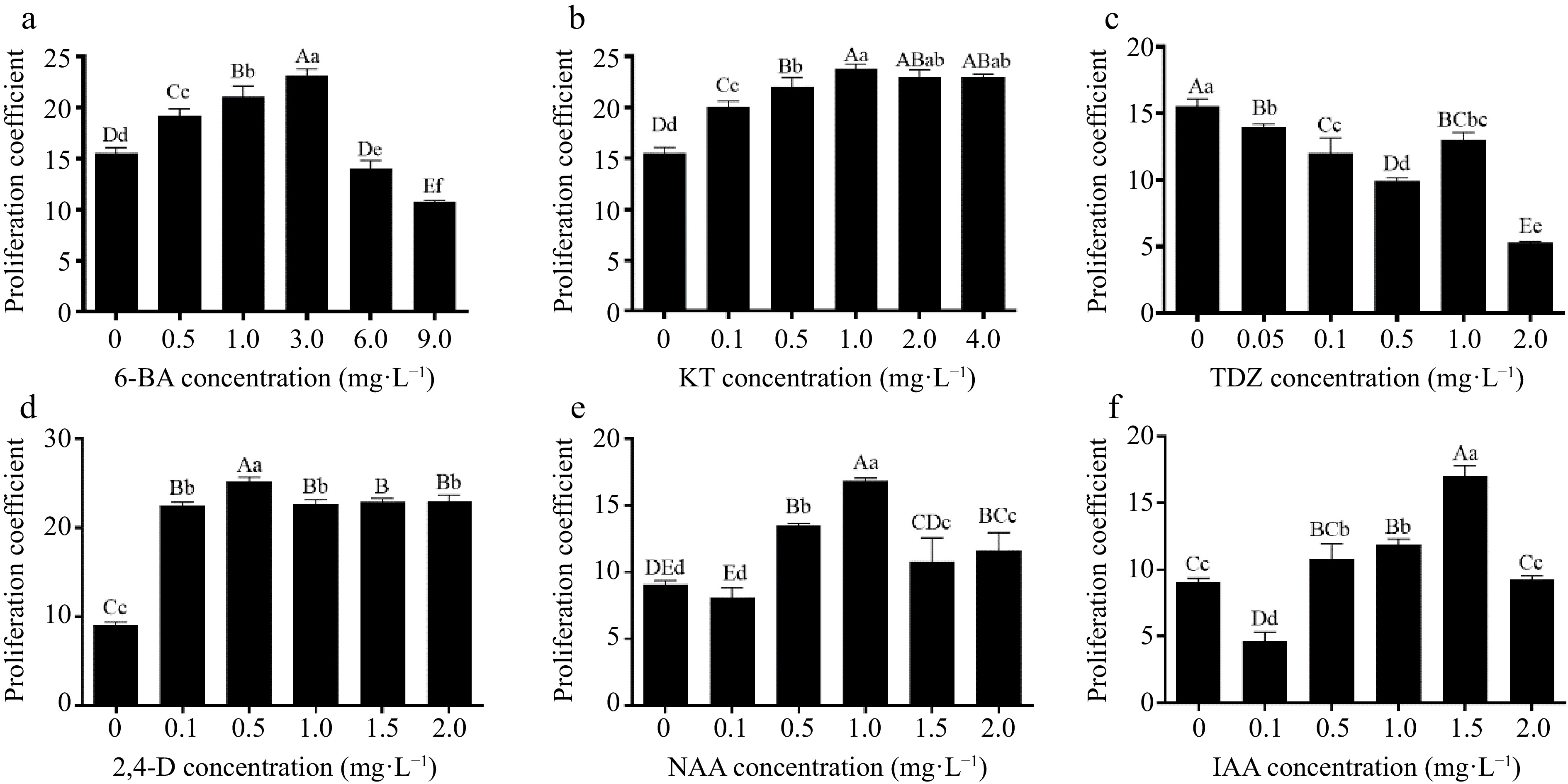-

Figure 1.
Callus culture of Amaranthus L. (a) PI 277269 hypocotyl in MS + BAP media could not promote callus formation. (b) PI 277269 hypocotyl in MS 0.5 mg·L−1 2,4-D media could promote callus formation until 60 d. (c) PI 277269 hypocotyl in MS + 3.0 mg·L−1 BAP + 0.5 mg·L−1 2,4-D could promote callus formation and growth in 20 d. (d) Ames 2141 hypocotyl in MS + 3.0 mg·L−1 BAP + 0.5 mg·L−1 2,4-D could induce callus, but these calli began to brown in a short time. (e), (f) The callus proliferation of PI 277269 in MS + 6.0 mg·L−1 BAP + 0.5 mg·L−1 2,4-D medium for 3 years. (g) The suspension cells of PI 277269 in MS + 6.0 mg·L−1 BAP + 0.5 mg·L−1 2,4-D medium for 16 d. Microscopic observation of (h) callus and (i) suspension cells.
-

Figure 2.
The effect of different concentrations of cytokinins and auxins on the proliferation of amaranth callus. Upper case letters indicate p < 0.01, lower case letters indicate p < 0.05. The same letter indicates no significant difference.
-

Figure 3.
Growth curve of callus of Amaranthus tricolor L.
-

Figure 4.
The effect of different concentrations of cytokinin on total flavonoid content and yield in amaranth callus. Upper case letters indicate p < 0.01, lower case letters indicate p < 0.05. The same letter indicates no significant difference.
-

Figure 5.
The effect of different concentrations of auxin on total flavonoid content and yield in amaranth callus. Upper case letters indicate p < 0.01, lower case letters indicate p < 0.05. The same letter indicates no significant difference.
-
Plant ID Plant name Taxonomy Induction rate (%) Origin PI 606282 Lal Shak Amaranthus blitum subsp. Oleraceus 89.17 ± 1.91 a Bangladesh PI 572261 AMA57/81 Amaranthus powellii subsp. Bouchoni 50.57 ± 3.95 c Germany PI 277269 Lal Sag Amaranthus tricolor 90.67 ± 1.55 a India Ames 18049 Ramdana Amaranthus tricolor 78.63 ± 0.49 b Nepal PI 604669 White leaf Amaranthus tricolor 87.27 ± 1.07 a China, Taiwan Ames 5110 RRC321 Amaranthus tricolor 95.03 ± 2.25 a West Africa Ames 5134 Tampala Amaranthus tricolor 67.07 ± 1.46 bc United States, Pennsylvania Ames 5311 Fota Kira Amaranthus tricolor 87.53 ± 1.27 a India Ames 15328 RRC359 Amaranthus tricolor 69.37 ± 2.67 b United States PI 527321 BAILIUYEXIAN Amaranthus tricolor 77.9 ± 4.36 b China PI 607446 Crystal Amaranthus tricolor 94.67 ± 4.03 a Thailand Ames 2141 RRC228 Amaranthus tricolor 70.8 ± 2.62 b India, Tamil Nadu Means ± STD followed with the same letters are not significantly different using DMRT at α = 0.05. Table 1.
Effects of genotype on induction of callus in Amaranthus spp.
-
Hormones Callus
colorCompaction Induction
rate (%)Induction
time (d)1.5 mg·L−1 BAP − − 0 c − 0.5 mg·L−1 2,4-D Red − 72.33 ± 5.17 b 60 1.0 mg·L−1 2,4-D Red − 66.97 ± 1.40 b 60 3.0 mg·L−1 BAP +
0.5 mg·L−1 NAARed and yellow Loose 93.7 ± 0.72 a 20 3.0 mg·L−1 BAP +
0.5 mg·L−1 2,4-DWhite Compact 92.67 ± 2.41 a 20 Means ± STD followed with the same letters are not significantly different using DMRT at α = 0.05. Table 2.
Effects of hormones on callus induction in Amaranth 'PI 277269'.
Figures
(5)
Tables
(2)